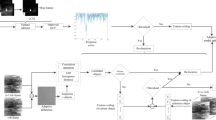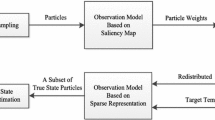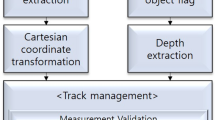Abstract
A precise method for accurately tracking dim-small targets, based on spectral fingerprint is proposed where traditional full color tracking seems impossible. A fingerprint model is presented to adequately extract spectral features. By creating a multidimensional feature space and extending the limited RGB information to the hyperspectral information, the improved precise tracking model based on a nonparametric kernel density estimator is built using the probability histogram of spectral features. A layered particle filter algorithm for spectral tracking is presented to avoid the object jumping abruptly. Finally, experiments are conducted that show that the tracking algorithm with spectral fingerprint features is accurate, fast, and robust. It meets the needs of dim-small target tracking adequately.
Similar content being viewed by others
References
Doucet A, Gordon N, Krishnamurthy V. Particle filters for state estimation of jump Markov linear systems. IEEE Transactions on Signal Processing, 2001, 49(3): 613–624
Gao J, Kosaka A, Kak A. A multi-Kalman filtering approach for video tracking of human-delineated objects in cluttered environments. Computer Vision and Image Understanding, 2005, 99(1): 1–57
Meyer M, Ohmacht T, Bosch R, Hotter M. Video surveillance applications using multiple views of a scene. IEEE Aerospace and Electronic Systems Magazine, 1999, 14(3): 13–18
Wang L, Hu S, Zhang X. Detecting and tracking of small moving target under the background of sea level. In: Proceedings of the 9th International Conference on Signal Processing. 2008, 989–992
Hamdulla A, Xiang G, Tursun D. A particle filter and fuzzy clustering based algorithm for tracking dim moving multiple point targets in ir image sequence. In: Proceedings of 2009 WRI World Congress on Computer Science and Information Engineering. 2009, 205–209
Chen J, An G, Zhang S, Wu Z. Small target tracking based on histogram interpolation mean shift. Journal of Electronics and Information Technology, 2010, 32(9): 2119–2125
Neumann J. DMD based hyperspectral augmentation for multi-object tracking systems. In: Proceedings of Emerging Digital Micromirror Device Based Systems and Applications, SPIE-7210. 2009, 110–119
Varsano L, Rotman S. Point target tracking in hyperspectral images. In: Proceedings of Algorithms and Technologies for Multispectral, Hyperspectral, and Ultraspectral Imagery XI, SPIE-5806. 2005, 503–512
Varsano L, Yatskaer I, Rotman S. Temporal target tracking in hyperspectral images. Optical Engineering, 2006, 45(12): 126201
Aminov B, Nichtern O, Rotman S. Spatial and temporal point tracking in real hyperspectral images. EURASIP Journal on Advances in Signal Processing, 2011, 2011(1): 1–25
Rosario D, Kling H. Hyperspectral object tracking using small sample size. In: Hyperspectral, and Ultraspectral Imagery XVI, SPIE-7695. 2010, 230–238
Banerjee A, Burlina P, Broadwater J. Hyperspectral video for illumination-invariant tracking. In: Proceedings of the 1st Workshop on Hyperspectral Image and Signal Processing: Evolution in Remote Sensing. 2009, 1–4
Kerekes J, Baum J. Hyperspectral imaging system modeling. Lincoln Laboratory Journal, 2003, 14(1): 117–130
Wang T, Zhu Z, Blasch E. Bio-inspired adaptive hyperspectral imaging for real-time target tracking. IEEE Sensors Journal, 2010, 10(3): 647–654
Nguyen H V, Banerjee A, Chellappa R. Tracking via object reflectance using a hyperspectral video camera. In: Proceedings of IEEE Conference on Computer Vision and Pattern Recognition Workshops. 2010, 44–51
Garcia-Allende P, Conde O, Mirapeix J, Cobo A, Lopez-Higuera J. Quality control of industrial processes by combining a hyperspectral sensor and Fisher’s linear discriminant analysis. Sensors and Actuators B: Chemical, 2008, 129(2): 977–984
Wettle M, Daniel P, Logan G, Thankappan M. Assessing the effect of hydrocarbon oil type and thickness on a remote sensing signal: a sensitivity study based on the optical properties of two different oil types and the hymap and quickbird sensors. Remote Sensing of Environment, 2009, 113(9): 2000–2010
Delabrouille J, Cardoso J, Patanchon G. Multi-detector multicomponent spectral matching and applications for cmb data analysis. Monthly Notices of the Royal Astronomical Society. 2002, 1–16
Blackburn J, Mendenhall M, Rice A, Shelnutt P, Soliman N, Vasquez J. Feature aided tracking with hyperspectral imagery. In: Proceedings of Signal and Data Processing of Small Targets, SPIE-6699. 2007, 1–12
Author information
Authors and Affiliations
Corresponding author
Additional information
Hao Sheng Received his BS and PhD degrees from the School of Computer Science and Engineering of Beihang University in 2003 and 2009, respectively. Now he is an assistant professor at Beihang University. He is working on computer vision, intelligent transportation systems, and hyperspectral remote sensing.
Chao Li Received his BS and PhD degrees in computer science and technology from Beihang University in 1996 and 2005, respectively. Now he is an associate professor and MS supervisor in the School of Computer Science and Engineering, Beihang University. Currently, he is working on data vitalization and computer vision.
Yuanxin Ouyang Received her BS and PhD degrees in computer science and technology from Beihang University in 1996 and 2005, respectively. Now she is an associate professor and MS supervisorin in the School of Computer Science and Engineering, Beihang University. She is working on data vitalization, web applications, and distributed systems.
Zhang Xiong Received his BS degree from Harbin Engineering University in 1982. He Received his MS degree from Beihang University in 1985. He is a professor and PhD supervisor in the School of Computer Science and Engineering, Beihang University. He is working on computer vision, wireless sensor networks, information security, and data vitalization.
Rights and permissions
About this article
Cite this article
Sheng, H., Li, C., Ouyang, Y. et al. A precise approach to tracking dim-small targets using spectral fingerprint features. Front. Comput. Sci. 6, 527–536 (2012). https://doi.org/10.1007/s11704-012-1106-2
Received:
Accepted:
Published:
Issue Date:
DOI: https://doi.org/10.1007/s11704-012-1106-2




